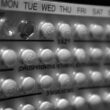If you are considering using a fertility app to avoid pregnancy you may find it difficult to select one that meets your needs. There is an ever-growing number of options, but how do you know their effectiveness? How much evidence supports these apps’ claims? A new study published in the Journal of the American Board of Family Medicine brings this much needed information.
In this blog article, we will not only reveal the names of the best fertility apps on the market, but we’ll also explain important aspects of the study that may guide your choice.
The sponsor of the study is FACTS, a nonprofit organization led by medical professionals and educators with the mission to educate their peers about fertility awareness based methods (FABMs). For this article I interviewed Dr. Marguerite Duane, MD, Executive Director of FACTS, and Alison Contreras, PhD, FCP, who served as the Director of Programs and the Project Manager for the study.
Beginning with 95 apps, the researchers eliminated 55 that either didn’t claim to be based on an FABM, or explicitly excluded use for avoiding pregnancy. The remaining 40 apps were then evaluated using a method adapted from the one used by the Family Practice Management Journal to rate medical apps in general. The study rated each of them for their effectiveness and user-friendliness.
What you need to know first
A cycle tracking or fertility app can be used to prevent pregnancy very effectively if it helps you to identify the “fertile window” within your cycle. With this knowledge, you can avoid (or achieve) pregnancy by choosing when you have intercourse depending on your family planning goals. Modern fertility awareness based methods (FABMs) teach women to accurately identify the 7 to 10 days of potential fertility. Most smartphone apps use this expertise to design their programs. However, if the app is NOT based on an accurate, evidence based FABM, the risk of pregnancy can be high.
Before choosing an app to avoid pregnancy, it is critical to have a basic understanding of key differences among the FABMs they are based on.
For instance, many apps are designed using calendar calculations. The calendar method is the least reliable FABM. It was discovered and formalized in the 1930’s; scientific knowledge and technology has evolved well beyond it.
Newer FABMs such as the Ovulation method or the Sympto-Thermal method are much more precise and effective in avoiding or achieving pregnancy. You can read here how their effectiveness rates are a match for conventional contraceptive methods. Obviously, these methods have the huge advantage over artificial birth control of avoiding side effects and health risks.
A number of the apps tested by FACTS were based on calendar calculations, and they didn’t do well because the effectiveness of the method is low. However, several apps based on modern FABMs did very well and can be recommended.
Another consideration is that apps that are based on FABMs require you to observe natural biomarkers of your body, including cervical fluid and basal temperature. To get the most accurate fertile window, you need to know how to observe these biomarkers. That’s the fundamental knowledge you will gain when learning from an official FABM training organization. For optimal effectiveness, smartphones apps must also provide an equally high level of guidance and support to new users in reading their biomarkers.
The study goals and method
The study was designed under the supervision of a team of six physicians and several other experts in fertility awareness. Dr. Duane and Dr. Contreras recruited, trained and monitored 12 volunteers who conducted the testing.
The primary goal of the study was to identify apps that can be used by couples to avoid pregnancy and evaluate how reliable they were in doing so. The most important factors in their rating system were:
- Authoritativeness: did the developer use an evidence-based FABM to define the rules of the app, and did the developer cite the source?
- The accuracy of the app in identifying the fertility window: rating was based on the FABM’s effectiveness, and then on the accuracy of the calculation by the app
- The support provided by the manufacturer.
Secondary factors included adaptability, ease of use and cost.
To check each fertility app, the FACTS team used the biomarker data from seven cycles, which varied in length. For each cycle, they calculated the fertile window using the rules from evidence-based FABMs (such as Billings, Creighton, Sympto-thermal, Standard Days). Then they asked the team to enter the same cycle data in the apps and report what fertile window the app predicted. If the fertile window from the app matched the manual calculation, the app did very well. Some apps don’t calculate the fertile window for you, and these apps were rated separately.
The results
The results showed that 30 apps predicted days of fertility for the user. In other words, when you enter the biomarkers, your app will tell you the days there is a risk of getting pregnant. Of the 30, six apps had either a perfect score on accuracy or no false negatives (days of fertility that the app said were infertile).
The 10 apps that do not predict fertile days could still score high on accuracy if they required women to receive training in an FABM prior to using the app, which was the case for some of them.
Here are the overall scores by app:
For app that predicts the fertility window, the ones recommended by FACTS are the ones that got a 4 on the accuracy and authority ratings.
| Ranking | Name of App | FABM | Platforms Available | Accuracy and Authority Score (Mean) | Total Score (Mean) |
| Apps that predict fertile days (n = 30) | |||||
| 1 | Ovulation Mentor* | Ovulation | Web | 4.7 | 4.4 |
| 2 | Sympto.org* | Symptothermal method | iOS/Android/Web | 4.5 | 4.1 |
| 3 | iCycleBeads* | Standard days method | iOS | 4.3 | 3.9 |
| 4 | LilyPro* | Symptothermal method | iOS | 4.3 | 3.8 |
| 5 | Lady Cycle* | Symptothermal method | Android | 4.3 | 4.1 |
| 6 | mfNFP.net* | Symptothermal method | iOS/Android/Web | 4 | 4 |
| 7 | MyFertilityCharts.com | Symptothermal method | iOS/Android/Web | 3.5 | 3.7 |
| 8 | CycleProGo | Symptothermal method | iOS/Android/Web | 3.4 | 3.9 |
| 9 | 2Day Method | Two day | iOS | 3.3 | 3.2 |
| 10 | Ova Ova | Symptothermal method | Web | 3.3 | 3.3 |
| 11 | OvaGraph | Symptothermal method | iOS/Android/Web | 3.1 | 3.6 |
| 12 | OvuView | Symptothermal method | Android | 2.7 | 2.8 |
| 13 | FemCal | Symptothermal method | iOS | 2.5 | 2.2 |
| 14 | Ovatemp | Symptothermal method | iOS | 2.3 | 3.2 |
| 15 | Natural Cycles | Proprietary | iOS/Android | 2.3 | 3.1 |
| 16 | Cyclendar | Symptothermal method | Web | 2.1 | 2.2 |
| 17 | My Fertility MD | Ovulation | iOS | 2.1 | 3.2 |
| 18 | Menstrual Cycle Woman Log | Rhythm^ | Android | 2.1 | 1.9 |
| 19 | Menstruation & Ovulation | Rhythm | iOS | 2.1 | 1.2 |
| 20 | Cycles | Standard days method | iOS | 1.7 | 2.2 |
| 21 | iCyclus | Rhythm | iOS | 1.3 | 1.4 |
| 22 | Period Log | Rhythm | iOS | 1.1 | 1.8 |
| 23 | Period Pace | Rhythm | iOS | 1 | 1.7 |
| 24 | Period & Ovulation Calendar | Rhythm | iOS | 1 | 1.5 |
| 25 | Pink Pad Pro | Rhythm | iOS/Android | 1 | 2.3 |
| 26 | Fertility Calendar | Rhythm | Android | 1 | 1.4 |
| 27 | Fertility Clock | Rhythm | iOS | 0.7 | 1.4 |
| 28 | Woman Calendar | Rhythm | iOS | 0.7 | 1.2 |
| 29 | Fertility & Ovulation | Rhythm | iOS | 0.5 | 1.6 |
| 30 | Glow | Proprietary | iOS/Android | 0 | 1.8 |
Apps that don’t predict the fertile window can also be very useful to record your observations. You have to be knowledgeable and follow the rules of your chosen method to identify the fertile window based on your observations.
| Ranking | Name of App | FABM | Platforms Available | Accuracy and Authority Score (Mean) | Total Score (Mean) |
| Apps that did not predict fertile days (n = 10) | |||||
| 1 | NFP Charting | Ovulation | iOS/Android/Web | 4.5 | 4.6 |
| 2 | Fertility Pinpoint | Ovulation | Web | 4.2 | 4.3 |
| 3 | Kindara | Symptothermal method | iOS/Android | 4.1 | 4.3 |
| 4 | Symptopro | Symptothermal method | Web | 3.7 | 3.7 |
| 5 | Groove Fertility Pro | Symptothermal method | iOS | 3.2 | 3.4 |
| 6 | FEMM | Symptohormonal method | iOS | 3.2 | 3 |
| 7 | Lady Timer | Rhythm | Android | 2.5 | 2.5 |
| 8 | Charting App | Ovulation | Android | 2.3 | 2.4 |
| 9 | Knowhen | Proprietary | iOS | 2.2 | 1.8 |
| 10 | NFP Project Caruso | Ovulation | Android | 2.1 | 2.1 |
So how can you decide which app is best for you?
First, if you are not trained in charting already, we highly recommend using one of the top 6 apps. They will be doing the work of interpretation of your biomarkers for you and do so most accurately. You still have to learn how to read these biomarkers, so it is still best to learn how to use the method from a qualified teacher, but some of these apps may have a formal support system that can be a lot of help.
If you are already trained in using an FABM and are looking for an app as a technology support, which is great to record your cycles and share them with an instructor, you can be more free to choose from apps with a lower accuracy rating and of course apps that don’t predict the window of fertility. Other considerations may come into play then, such as the app’s ease of use, platform, costs, etc..
Avoid the lowest rated apps. Some apps are inviting women to record advanced biomarkers like basal body temperature and cervical fluid but they identify a fertile window using the calendar calculations, which is completely erroneous. You can sometimes find out in the intro or in the help section of the app what method they rely on. If they say “rhythm method” or “calendar method” we caution you against using them to avoid pregnancy.
Although it rated very well, iCycleBeads, the only rated app based on the Standard Days method, only works for women who have cycles consistently between 26-32 days. Also, the fertile window tends to be longer than with more precise methods, meaning a longer abstinence time.
Some very popular apps like Natural Cycle, Ovatemp, or Glow use proprietary methods for their software, which means that they are not following the rules of an evidence-based FABM. As a result, the study couldn’t give them a good rating, having no information about the method effectiveness. It doesn’t mean they are ineffective, but it is up to them to provide the evidence that they are, and we encourage our readers to find out the studies these manufacturers have done before relying on these apps.
In closing
The good news for women who are looking to avoid pregnancy without contraceptives is that modern technology is catching up with science in a way that can really help them. Apps can be amazing tools to chart and manage your fertility, as witnessed by the millions of women who have already used them.
“There is a still a need for more apps that follow evidence-based methods,” said Alison Contreras. We congratulate the app companies that have done so already, and we hope that more of them will strive to provide a service based on modern FABMs and follow their rules. The science has evolved and new apps should reflect those advances. Women deserve the best accuracy possible.
We also continue to encourage women to learn how to track their fertility from a qualified teacher. It’s a lifelong skill that will give them more freedom when choosing an app and more confidence in their practice of a natural method.








Thanks, very interesting. Surprised not to see Ovusoft, erstwhile associated with TCOYF.
What about DOT? Is there any info on that?
This article is very done, nicely combining a scientific journal article with a blog post that breaks down the information so every day women can understand it. Congrats and I look forward to more posts on the topic of effective FABM products.